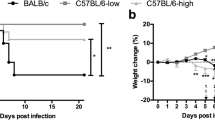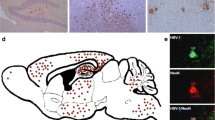Abstract
Herpes simplex virus type 1 (HSV-1) is a human pathogen that may cause severe encephalitis. The exacerbated immune response against the virus contributes to the disease severity and death. Platelet activating factor (PAF) is a mediator capable of inducing increase in vascular permeability, production of cytokines on endothelial cells and leukocytes. We aimed to investigate the activation of PAF receptor (PAFR) and its contribution to the severity of the inflammatory response in the brain following HSV-1 infection. C57BL/6 wild-type (WT) and PAFR deficient (PAFR−/−) mice were inoculated intracranially with 104 plaque-forming units (PFU) of HSV-1. Visualization of leukocyte recruitment was performed using intravital microscopy. Cells infiltration in the brain tissue were analyzed by flow cytometry. Brain was removed for chemokine assessment by ELISA and for histopathological analysis. The pharmacological inhibition by the PAFR antagonist UK-74,505 was also analyzed. In PAFR−/− mice, there was delayed lethality but no difference in viral load. Histopathological analysis of infected PAFR−/− mice showed that brain lesions were less severe when compared to their WT counterparts. Moreover, PAFR−/− mice showed less TCD4+, TCD8+ and macrophages in brain tissue. This reduction of the presence of leukocytes in parenchyma may be mechanistically explained by a decrease in leukocytes rolling and adhesion. PAFR−/− mice also presented a reduction of the chemokine CXCL9 in the brain. In addition, by antagonizing PAFR, survival of C57BL/6 infected mice increased. Altogether, our data suggest that PAFR plays a role in the pathogenesis of experimental HSV-1 meningoencephalitis, and its blockade prevents severe disease manifestation.


Similar content being viewed by others
References
Aihara M, Ishii S, Kume K, Shimizu T (2000) Interaction between neurone and microglia mediated by platelet-activating factor. Genes Cells 5:397–406
Amaral DC, Rachid MA, Vilela MC, Campos RD, Ferreira GP, Rodrigues DH, Lacerda-Queiroz N, Miranda AS, Costa VV, Campos MA, Kroon EG, Teixeira MM, Teixeira AL (2011) Intracerebral infection with dengue-3 virus induces meningoencephalitis and behavioral changes that precede lethality in mice. J Neuroinflammation 8:23
Anglen CS, Truckenmiller ME, Schell TD, Bonneau RH (2003) The dual role of CD8+ T lymphocytes in the development of stress induced herpes simplex encephalitis. J Neuroimmunol 140:13–27
Aravalli RN, Peterson PK, Lokensgard JR (2007) Toll-like receptors in defense and damage of the central nervous system. J NeuroImmune Pharmacol 2:297–312
Baringer JR (2008) Herpes simplex infections of the nervous system. Neurol Clin 26:657–674
Bedirli A, Gokahmetoglu S, Sakrak O, Soyuer I, Ince O, Sozuer E (2004) Beneficial effects of recombinant platelet-activating factor acetylhydrolase and BN 52021 on bacterial translocation in cerulein-induced pancreatitis. Eur Surg Res 36:136–141
Bloom DC, Giordani NV, Kwiatkowski DL (2010) Epigenetic regulation of latent HSV-1 gene expression. Biochim Biophys Acta 1799:246–256
Cabellos C, MacIntyre DE, Forrest M, Burroughs M, Prasad S, Tuomanen E (1992) Differing roles for platelet-activating factor during inflammation of the lung and subarachnoid space. The special case of Streptococcus pneumoniae. J Clin Invest 90:612–618
Campos MA, Kroon EG (1993) Critical period of irreversible block of vaccinia virus replication. Rev Microbiol 24:104–110
Domingues RB, Teixeira AL (2009) Management of acute viral encephalitis in Brazil. Braz J Infect Dis 136:433–439
Garcia CC, Russo RC, Guabiraba R, Fagundes CT, Polidoro RB, Tavares LP, Salgado AP, Cassali GD, Sousa LP, Machado AV, Teixeira MM (2010) Platelet-activating factor receptor plays a role in lung injury and death caused by influenza a in mice. PLoS Pathog 6:e1001171
Halford WP, Gebhardt BM, Carr DJJ (1996) Mechanisms of herpes virus type 1 reactivation. J Virol 70:5051–5060
Hu S, Sheng WS, Schachtele SJ, Lokensgard JR (2011) Reactive oxygen species drive herpes simplex virus (HSV)-1-induced proinflammatory cytokine production by murine microglia. J Neuroinflammation 8(123):1–9
Ishii S, Shimizu T (2000) Platelet-activating factor (PAF) receptor and genetically engineered PAF receptor mutant mice. Prog Lipid Res 39:41–82
Issekutz AC, Szpejda M (1986) Evidence that platelet activating factor may mediate some acute inflammatory responses. Studies with the platelet-activating factor antagonist, CV3988. Lab Investig 54:275–281
Joklik WK (1962) The purification for four strains of poxvirus. Virology 18:9–18
Kamei S, Taira N, Ishihara M, Sekizawa T, Morita A, Miki K, Shiota H, Kanno A, Suzuki Y, Mizutani T, Itoyama Y, Morishima T, Hirayanagi K (2009) Prognostic value of cerebrospinal fluid cytokine changes in herpes simplex virus encephalitis. Cytokine 46:187–193
Kawai T, Akira S (2010) The role of pattern-recognition receptors in innate immunity: update on toll-like receptors. Nat Immunol 11:373–384
Lacerda-Queiroz N, Rodrigues DH, Vilela MC, Rachid MA, Soriani FM, Sousa LP, Campos RD, Quesniaux VF, Teixeira MM, Teixeira AL (2012) Platelet-activating factor receptor is essential for the development of experimental cerebral malaria. Am J Pathol 180:246–255
Landgraf RG, Nossi DF, Sirois P, Jancar S (2007) Prostaglandins, leukotrienes and PAF selectively modulate lymphocyte subset and eosinophil infiltration into the airways in a murine model of asthma. Prostaglandins Leukot Essent Fat Acids 77:163–172
Liu MT, Armstrong D, Hamilton TA, Lane TE (2001a) Expression of Mig (monokine induced by interferon-gamma) is important in T lymphocyte recruitment and host defense following viral infection of the central nervous system. J Immunol 166:1790–1795
Liu MT, Keirstead HS, Lane TE (2001b) Neutralization of the chemokine CXCL10 reduces inflammatory cell invasion and demyelination and improves neurological function in a viral model of multiple sclerosis. J Immunol 167:4091–4097
Loetscher M, Gerber B, Loetscher P, Jones SA, Piali L, Clark-Lewis I, Baggiolini M, Moser B (1996) Chemokine receptor specific for IP10 and mig: structure, function, and expression in activated T-lymphocytes. J Exp Med 184:963–969
Menasria R, Boivin N, Lebel M, Piret J, Gosselin J, Boivin G (2013) Both TRIF and IPS-1 adaptor proteins contribute to the cerebral innate immune response against herpes simplex virus 1 infection. J Virol 87(13):7301–7308
Milatovic D, Zhang Y, Olson SJ, Montine KS, Roberts LJ, Morrow JD, Montine TJ, Dermody TS, Valyi-Nagy T (2002) Herpes simplex virus type 1 encephalitis is associated with elevated levels of F2-isoprostanes and F4-neuroprostanes. J Neurovirol 8:295–305
Musto AE, Samii M (2011) Platelet-activating factor receptor antagonism targets neuroinflammation in experimental epilepsy. Epilepsia 52:551–561
Persidsky Y, Limoges J, Rasmussen J, Zheng J, Gearing A, Gendelman HE (2001) Reduction in glial immunity and neuropathology by a PAF antagonist and an MMP and TNFalpha inhibitor in SCID mice with HIV-1 encephalitis. J Neuroimmunol 114:57–68
Raschilas F, Wolff M, Delatour F, Chaffaut C, De Broucker T, Chevret S, Lebon P, Canton P, Rozenberg F (2002) Outcome of and prognostic factors for herpes simplex encephalitis in adult patients: results of a multicenter study. Clin Infect Dis 35:254–260
Rodrigues DH, Lacerda-Queiroz N, de Miranda AS, Fagundes CT, Campos RD, Arantes RE, Vilela Mde C, Rachid MA, Teixeira MM, Teixeira AL (2011) Absence of PAF receptor alters cellular infiltrate but not rolling and adhesion of leukocytes in experimental autoimmune encephalomyelitis. Brain Res 1385:298–306
Romagnani P, Beltrame C, Annunziato F,. Lasagni L, Luconi M, Galli G, Cosmi L, Maggi E, Salvadori M, Pupilli C, Serio M (1999) Role for interactions between IP-10/mig and CXCR3 in proliferative glomerulonephritis. J Am Soc Nephrol 10:2518–2526.
Rösler A, Pohl M, Braune HJ, Oertel WH, Gemsa D, Sprenger H (1998) Time course of chemokines in the cerebrospinal fluid and serum during herpes simplex type 1 encephalitis. J Neurol Sci 157:82–89
Sadler AJ, Williams BR (2008) Interferon-inducible antiviral effectors. Nat Rev Immunol 8:559–568
Salmaggi A, Gelati M, Dufour A, Corsini E, Pagano S, Baccalini R, Ferrero E, Scabini S, Silei V, Ciusani E, De Rossi MJ (2002) Expression and modulation of IFN-gamma-inducible chemokines (IP-10, Mig, and I-TAC) in human brain endothelium and astrocytes: possible relevance for the immune invasion of the central nervous system and the pathogenesis of multiple sclerosis. Interferon Cytokine Res 22:631–640
Sellner J, Dvorak F, Zhou Y, Haas J, Kehm R, Wildemann B, Meyding-Lamadè U (2005) Acute and long-term alteration of chemokine mRNA expression after anti-viral and anti-inflammatory treatment in herpes simplex virus encephalitis. Neurosci Lett 374:197–202
Shields PL, Morland CM, Salmon M, Qin S, Hubscher SG, Adams DH (1999) Chemokine and chemokine receptor interactions provide a mechanism for selective T cell recruitment to specific liver compartments within hepatitis C-infected liver. J Immunol 163:6236–6243
Souza DG, Pinho V, Soares AC, Shimizu T, Ishii S, Teixeira MM (2003) Role of PAF receptors during intestinal ischemia and reperfusion injury. A comparative study between PAF receptor-deficient mice and PAF receptor antagonist treatment. Br J Pharmacol 139:733–740
Souza DG, Fagundes CT, Sousa LP, Amaral FA, Souza RS, Souza AL, Kroon EG, Sachs D, Cunha FQ, Bukin E, Atrasheuskaya A, Ignatyev G, Teixeira MM (2009) Essential role of platelet-activating factor receptor in the pathogenesis of dengue virus infection. Proc Natl Acad Sci U S A 106:14138–14143
Stafforini DM, McIntyre TM, Zimmerman GA, Prescott SM (2003) Platelet-activating factor, a pleiotrophic mediator of physiological and pathological processes. Crit Rev Clin Lab Sci 40:643–672
Tang Q, Hendricks RL (1996) Interferon gamma regulates platelet endothelial cell adhesion molecule 1 expression and neutrophil infiltration into herpes simplex virus-infected mouse corneas. J Exp Med 184:1435–1447
Townsend GC, Scheld WM (1994) Platelet-activating factor augments meningeal inflammation elicited by Haemophilus influenzae lipooligosaccharide in an animal model of meningitis. Infect Immun 62:3739–3744
Valko M, Leibfritz D, Moncol J, Cronin MT, Mazur M, Telser J (2007) Free radicals and antioxidants in normal physiological functions and human disease. Int J Biochem Cell Biol 39:44–84
Vilela MC, Mansur DS, Lacerda-Queiroz N, Rodrigues DH, Arantes RM, Kroon EG, Campos MA, Teixeira MM, Teixeira AL (2008) Traffic of leukocytes in the central nervous system is associated with chemokine up-regulation in a severe model of herpes simplex encephalitis: an intravital microscopy study. Neurosci Lett 445:18–22
Vilela MC, Mansur DS, Lacerda-Queiroz N, Rodrigues DH, Lima GK, Arantes RM, Kroon EG, da Silva Campos MA, Teixeira MM, Teixeira AL (2009) The chemokine CCL5 is essential for leukocyte recruitment in a model of severe herpes simplex encephalitis. Ann N Y Acad Sci 1153:256–263
Vilela MC, Lima GK, Rodrigues DH, Lacerda-Queiroz N, Mansur DS, de Miranda AS, Rachid MA, Kroon EG, Vieira LQ, Campos MA, Teixeira MM, Teixeira AL (2010) TNFR1 plays a critical role in the control of severe HSV-1 encephalitis. Neurosci Lett 479:58–62
Vilela MC, Lima GK, Rodrigues DH, Lacerda-Queiroz N, Pedroso VS, Miranda AS, Rachid MA, Kroon EG, Campos MA, Teixeira MM, Sellner J, Teixeira AL (2013) Absence of CCR5 increases neutrophil recruitment in severe herpetic encephalitis. BMC Neurosci 14:19
Whitley RJ, Roizman B (2001) Herpes simplex virus infections. Lancet 357:1513–1518
Acknowledgments
This work was supported by Conselho Nacional de Desenvolvimento Científico e Tecnológico (CNPq) and Fundação de Amparo a Pesquisa de Minas Gerais (Fapemig), Brazil.
Authors’ Contributions
MCV carried out immunological assays, intravital microscopy analysis and write the manuscript. GKL was responsible for the inoculation and quantification of the virus. DHR, NLQ, VSPP, ASM participated in immunological assays and intravital microscopy analysis. MAR performed the histopathological analysis. MAC and EGK participated in the design and coordination of the study. MMT contributed to write the manuscript. ALT designed the study and was responsible for the interpretation of experiments and editing the manuscript. All authors have read and approved the final version of the manuscript.
Author information
Authors and Affiliations
Corresponding authors
Ethics declarations
Competing Interests
The authors declare that they have no competing interests.
Rights and permissions
About this article
Cite this article
Vilela, M.C., Lima, G.K., Rodrigues, D.H. et al. Platelet Activating Factor (PAF) Receptor Deletion or Antagonism Attenuates Severe HSV-1 Meningoencephalitis. J Neuroimmune Pharmacol 11, 613–621 (2016). https://doi.org/10.1007/s11481-016-9684-7
Received:
Accepted:
Published:
Issue Date:
DOI: https://doi.org/10.1007/s11481-016-9684-7




